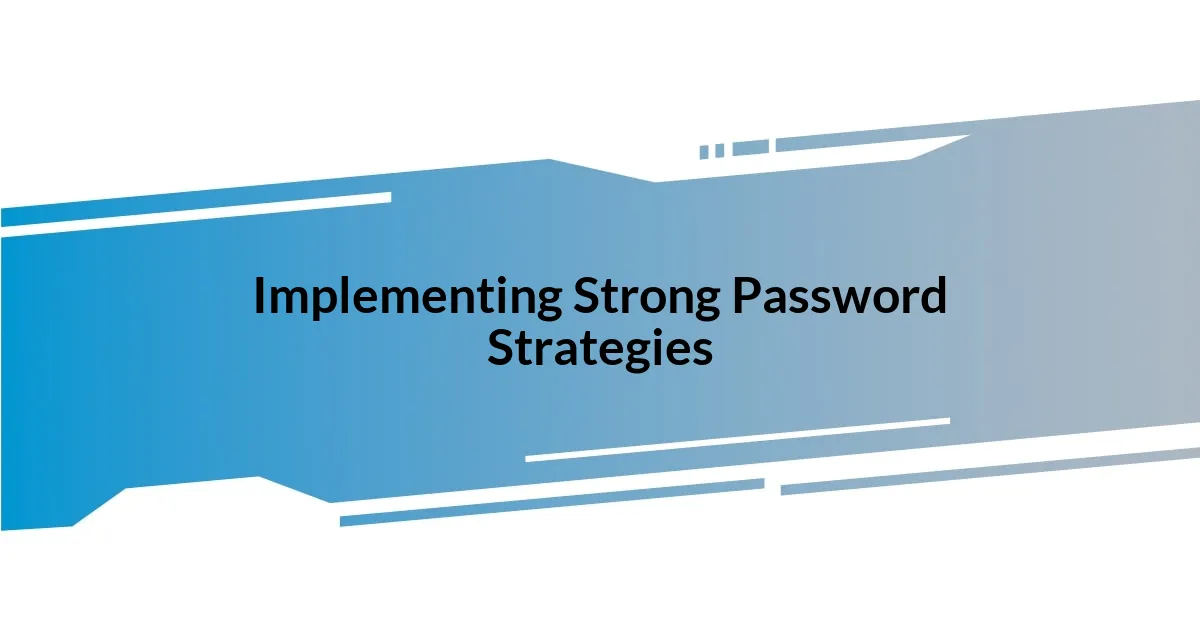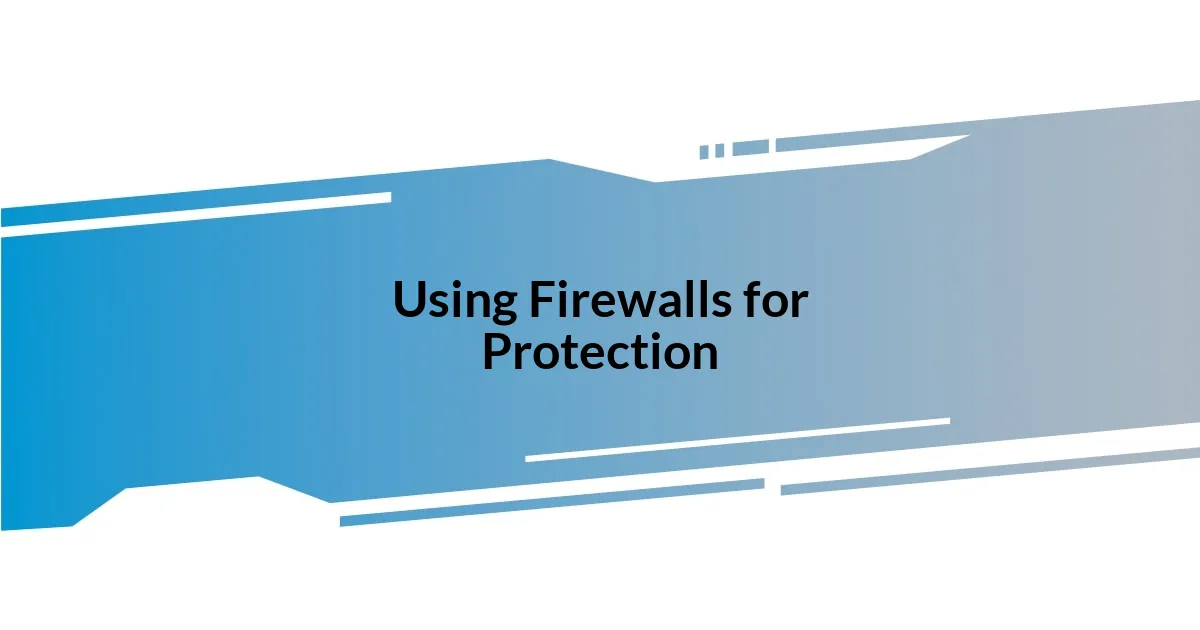Key takeaways:
- Understanding home network security is crucial as every device connected can be a potential target for cybercriminals; regular updates and vigilance are essential.
- Identifying vulnerabilities, such as open ports and weak passwords, is vital to fortifying your network against intrusions.
- Implementing strong password strategies and two-factor authentication greatly enhances your online security.
- Utilizing advanced security tools like firewalls, VPNs, and intrusion detection systems provides significant layers of protection for your home network.

Understanding Home Network Security
Understanding home network security is a vital concern for anyone who relies on the internet in their daily lives. I remember the unease I felt when a neighbor’s information got compromised; it really hit home when I realized how vulnerable my own devices could be. Have you ever stopped to think about how many devices are connected to your network? It’s astonishing how easily someone could slip in if we don’t take the right precautions.
Every device on your network, from smart TVs to baby monitors, can be a target for cybercriminals. I learned this firsthand when I discovered that my smart speaker was using an outdated firmware version, which made it susceptible to attacks. It’s a wake-up call! Securing your home network means regularly updating software and understanding the nature of each device connected to your network.
At times, it feels overwhelming to grasp how cyber threats work, but breaking it down can really help. I find it comforting to know that even small steps, like changing default passwords and enabling WPA3 encryption, greatly improve my home network’s defenses. Remember, investing the time to understand these concepts not only enhances your security but also provides peace of mind. Isn’t that worth it?

Identifying Vulnerabilities in Your Network
Identifying vulnerabilities in your network can feel a bit like detective work. I recall the nervous anticipation I felt while running a network security scan; it was unsettling to ponder what I might uncover. When I discovered open ports on my router, I realized I had to delve deeper into how they might expose my personal data. Prioritizing regular checks can significantly reduce the chance of unwanted intrusions.
Here are some key areas to examine for vulnerabilities:
- Open Ports: Identify any ports that are open unnecessarily, as they can be gateways for attackers.
- Weak Passwords: Regularly review and strengthen passwords for all devices; avoid using defaults.
- Firmware Updates: Ensure all devices are running the latest firmware to patch security vulnerabilities.
- Unsecured Wi-Fi: Check whether your Wi-Fi is secured with WPA3 encryption and change your SSID to something non-identifiable.
- Connected Devices: Keep track of all devices connected to your network; unknown devices could pose a risk.
Recognizing these vulnerabilities might seem daunting, but every small insight bolsters your defenses significantly. Ultimately, I found that facing these issues head-on transformed my anxiety into empowerment, knowing I was taking control of my home’s security.

Implementing Strong Password Strategies
Implementing strong password strategies has been a game-changer for me. I remember the surge of anxiety I felt when I learned about a friend’s account being hacked due to a simple password like “123456.” It struck me how easily I could fall into the same trap if I wasn’t careful. To prevent this, I started using long, complex passwords that combine letters, numbers, and symbols. Using a password manager helped me store these secure passwords without the pressure of memorizing each one.
On top of that, I learned the importance of enabling two-factor authentication (2FA) wherever possible. When I added an extra layer of security to my online accounts, it felt like I had locked my valuables in a safe. For instance, now, even if someone guessed my password, they’d still need a verification code sent to my phone. That’s peace of mind I wish everyone had!
Additionally, it’s crucial to update passwords regularly. At first, I found it tedious, but I discovered that setting a calendar reminder made the task manageable. Every three to six months, I change my passwords to strengthen my defenses. I’ve even adopted a fun method by using phrases that hold personal meaning to me, making it easier to remember while keeping it secure. How’s that for personalized security?
| Password Type | Strength Level |
|---|---|
| Simple (e.g., “password123”) | Weak |
| Complex (e.g., “T3$T@/Money!2023”) | Strong |
| Using a Password Manager | Very Strong |
| Two-Factor Authentication Enabled | Very Strong |
| Regularly Updated Passwords | Strong |

Using Firewalls for Protection
One of the best decisions I made for enhancing my home network security was using a firewall. Initially, I thought firewalls were complicated, but once I learned how they work, I realized they were crucial in protecting my network. A firewall acts as a barrier between your trusted internal network and untrusted external sources, allowing only safe traffic through. Can you imagine how reassuring it felt once I configured my firewall settings and blocked potential threats?
After setting up my firewall, I discovered the importance of customizing its rules. Many people overlook the default settings, but I quickly learned they might not provide adequate protection against modern threats. For example, I made it a point to block specific services running on my network that I didn’t use, which reduced the attack surface dramatically. Each time I updated these rules, I felt a bit more empowered—it’s like reinforcing the walls of my digital fortress!
There’s a certain satisfaction in regularly monitoring the firewall logs, too. At first, I felt overwhelmed by the technical jargon, but I gradually understood what various alerts meant. I remember feeling a rush of adrenaline the first time I spotted a blocked intrusion attempt. It was a stark reminder of why I invested my time in firewall protection. When you see those efforts manifesting in real-time, it transforms how you perceive your online safety. Isn’t it comforting to know you’re actively engaging in your digital security?

Regularly Updating Your Devices
Keeping your devices updated feels like a small task, but its impact on your home network security is significant. I vividly recall the moment my smartphone prompted me for a software update. Initially, I hesitated, thinking it was just a minor change. But that update brought vital security patches that combated recent threats. It dawned on me: ignoring updates can be like leaving my front door wide open.
One specific incident really drove this point home for me. I had a smart home device that went unupdated for months. After a recent news article highlighted vulnerabilities in similar devices, I took action. I managed to update it, feeling a sense of urgency. With each update, I imagined strengthening a barrier protecting my home from intruders. It’s astonishing how something as simple as regular updates can feel like applying layers of armor to my digital life, isn’t it?
Moreover, I discovered that enabling automatic updates is a lifesaver. The first time I set it up, I felt a wave of relief wash over me. Suddenly, I didn’t have to think about it — my gadgets were securing themselves in the background. That peace of mind has been invaluable. When was the last time you considered how effortless it could be to protect your devices? Embracing these updates is not just about performing a task; it’s about fostering a culture of security within your home.

Monitoring Network Activity
Monitoring my network activity was a game changer for enhancing my home network security. At first, I was simply curious about what devices were connected to my network. I decided to use a network monitoring tool, and boy, did it open my eyes! I recall the surprise of discovering an unknown device that had somehow connected. I couldn’t help but wonder how many other unsanctioned devices could be lurking. Taking the time to review my network activity not only empowered me but also kept potential threats at bay.
As I began to analyze patterns in my network traffic, I developed a keen sense of what “normal” looked like for my home. One evening, while checking my logs, I spotted unusual activity at a strange time of night. Panic set in as I realized someone was trying to access my system. Taking immediate action, I blocked that device and adjusted my settings. The relief that washed over me afterwards was overwhelming. I learned that vigilance really does pay off, and staying engaged with my network activity drastically improved my security stance.
Now, I make it a habit to periodically review my network activity logs and device lists. It’s become a routine that I actually look forward to; there’s a strange satisfaction in catching potential issues before they escalate. I often think about how easy it is to get complacent, but then I remind myself that being proactive is critical. Can you imagine feeling completely secure without ever checking your network’s status? I certainly couldn’t anymore—not after experiencing firsthand the power of regular monitoring.

Exploring Advanced Security Tools
Exploring advanced security tools truly opened a new realm for my network protection. One day, I decided to invest in a robust firewall after hearing about its potential to ward off threats. The installation process was surprisingly straightforward, yet the sense of security it brought was profound. I felt like I had upgraded my entire home with an impenetrable fortress. Could you imagine the peace of mind that accompanies knowing your data is tightly guarded?
Then there was the moment I stumbled upon a VPN, or Virtual Private Network. I remember feeling an mix of excitement and apprehension as I activated it for the first time. Suddenly, my online activities were cloaked from prying eyes, like donning a digital invisibility cloak. This not only protected my personal data when working from coffee shops but also provided additional layers of encryption. How could I have navigated the online world without such a tool? It was a true eye-opener for me.
This exploration led me to setting up intrusion detection systems, which felt like having a digital watchdog in my home. The first time I received an alert about a suspicious login attempt, my heart raced. I immediately checked the logs and blocked that access. Knowing I had that added layer of protection gave me a sense of empowerment. Have you considered how your online activities could benefit from similar tools? The ability to monitor and react in real time adds a new level to home network security that I now consider essential.